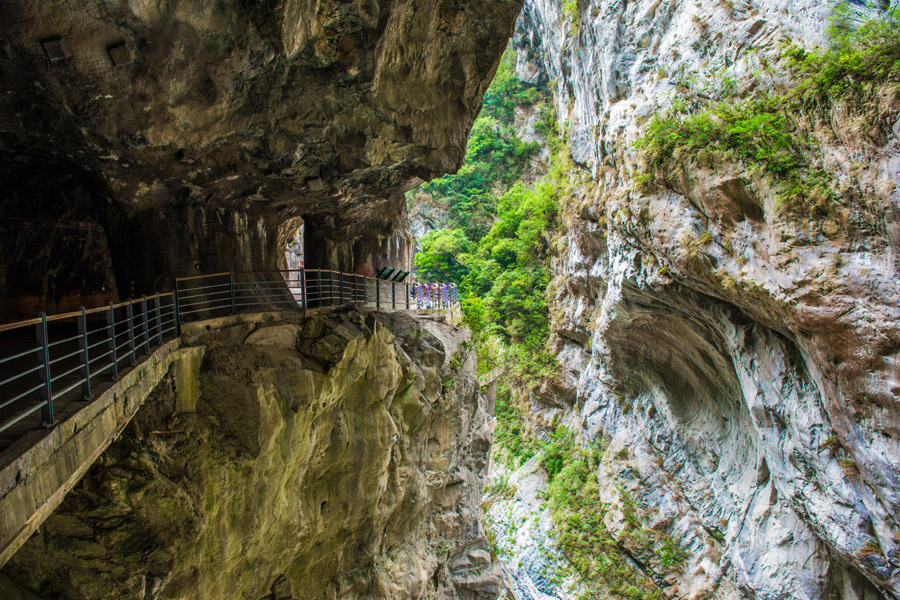[fshow photosetid=72157660807494997]
When people talk about Taiwan, they often talk about the Taiwan Miracle, referring to the island’s development from a former Japanese colony, relatively poor and underdeveloped, to one of the so-called Asian Tigers, spurred by first manufacturing and now various service industries. The country’s rich culture is well documented and foodies will have long ago read about Taiwan’s famous street food and night market culture.
Yet there is a different ‘miraculous’ side to Taiwan: its immense natural beauty and the government’s commitment to protecting it. In fact, the Taiwan Tourism Bureau under the government has identified 13 so-called National Scenic Areas that have been selected natural attractions on the basis of their unique characteristic and beauty. The north offers stunning coastal vistas and distinctive ecologies while rugged seaside cliffs and country scenery awaits those making their way down the east coast. For those looking for dramatic mountain views, the centre of Taiwan is the place to go.
Hualien
A great starting point for exploring the east coast of Taiwan is Hualien, the country’s second largest east coast city located just a few hours’ train ride southeast of Taipei. The city doesn’t have the sophistication of Taipei, or the buzz, but there is a nice, down-to-earth atmosphere and the people are friendly. Its surroundings are hard to beat; the city lies on a strip of land between the Central Mountain Gorge and the Pacific Ocean, offering scenic views of green and deep blue.
Most visitors to Hualien use the city as a base for river tracing and hiking in the Taroko Gorge and surrounding areas so there isn’t much in the way of man-made tourist attractions. Given its location by the sea there is lots of seafood on offer and the city is famous for its monk fish, a white fish commonly served in a clear soup. The city’s night market is an excellent place for sampling local specialties.
The Marble Gorge
One of Taiwan’s most popular tourist attractions is the Taroko Gorge, located inside the Taroko National Park in the East Coast National Scenic Area. The gorge, which is located just 20 kilometres north of Hualien, has an abundance of marble, leading to its nickname “The Marble Gorge” and its sheer rock walls has fascinated visitors for centuries. The formation of the gorge began more than 200 million years ago at the bottom of the ocean. Millions of years of pressure from the Philippine Sea Plate and the Eurasian Plate has pushed the limestone to the surface; in fact Taroko Gorge still rises by about 0.5 centimetres per year.
Visiting the Gorge is easy. There is a visitor’s centre with detailed information on the points of interest and there is even a shuttle bus departing from the bus station in Hualien, taking people into the gorge while stopping at various sights along the way. Simply hop off, explore the area and wait for the next shuttle bus to take you further afield. Most of the main attractions are open to the public, however a few require special permits to be attained in advance.
Biking the East Coast National Scenic Area
Taiwan has become a hot biking destination in recent years and highways 11 and 9 have become the country’s most popular due to the beauty of the east coast. Many people use Hualien as the starting point for the 180 kilometres ride to Taitung in the south. There are any number of ways to cover the distance between Hualien and Taitung: while Highway 11 follows the coast for long stretches at a time and doesn’t require much in terms of stamina and biking experience, Highway 9 is decidedly more challenging, taking the rider through valleys and significant elevation. The two highways are connected by various smaller roads where rice fields and small aboriginal villages await.
Seeing Taiwan by bike is probably one of the best ways to really get a glimpse of the country’s natural beauty and way of life on the country side far from the lights of Taipei. The island’s rich aboriginal culture is still evident in its many aboriginal villages where tribes still sustain themselves by fishing and farming the land.
Biking has become so popular that the infrastructure for independent bikers is one of the best in Asia. Several places offer multi-day bike rentals and a few companies even lets the biker rent the bike in one city and return it in another. There are several guest houses, cafes and restaurants, so rest, food and water is never far away.
Tips:
- Always follow the directions of the visitor’s centre in Taroko Gorge; heavy rainfall and Taiwan’s propensity for earth quakes sometimes result in rock falling from the gorge and injuring visitors.
- Ask for a map and bike reparation gear at the bike rental shop and make sure you have the correct phone numbers in case something more serious happens to the bike.
- The best way to visit Taiwan is from September to November when the weather is mild. Summers can get very hot and humid and monsoon offers heavy rainfall, sometimes for days on end.

